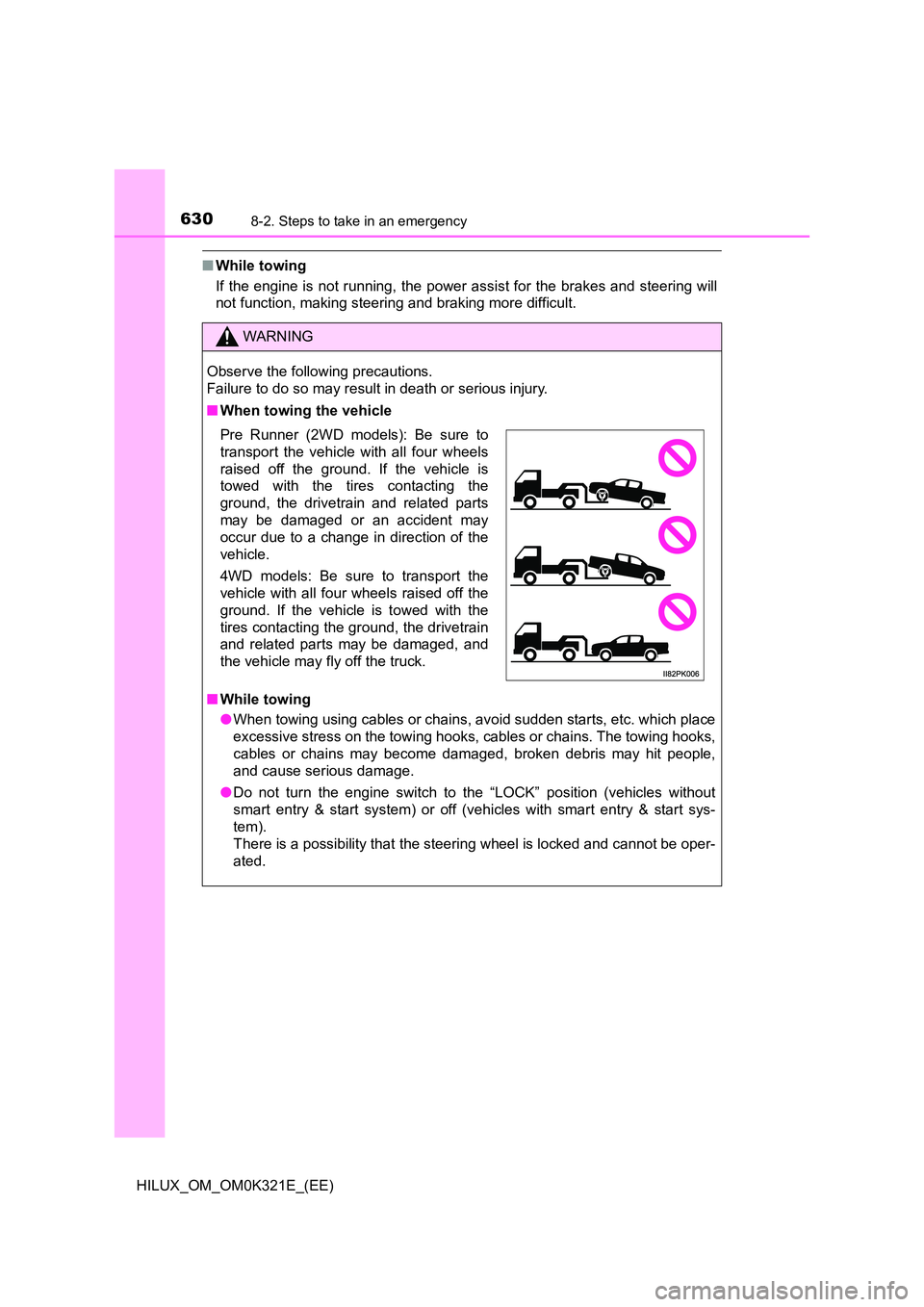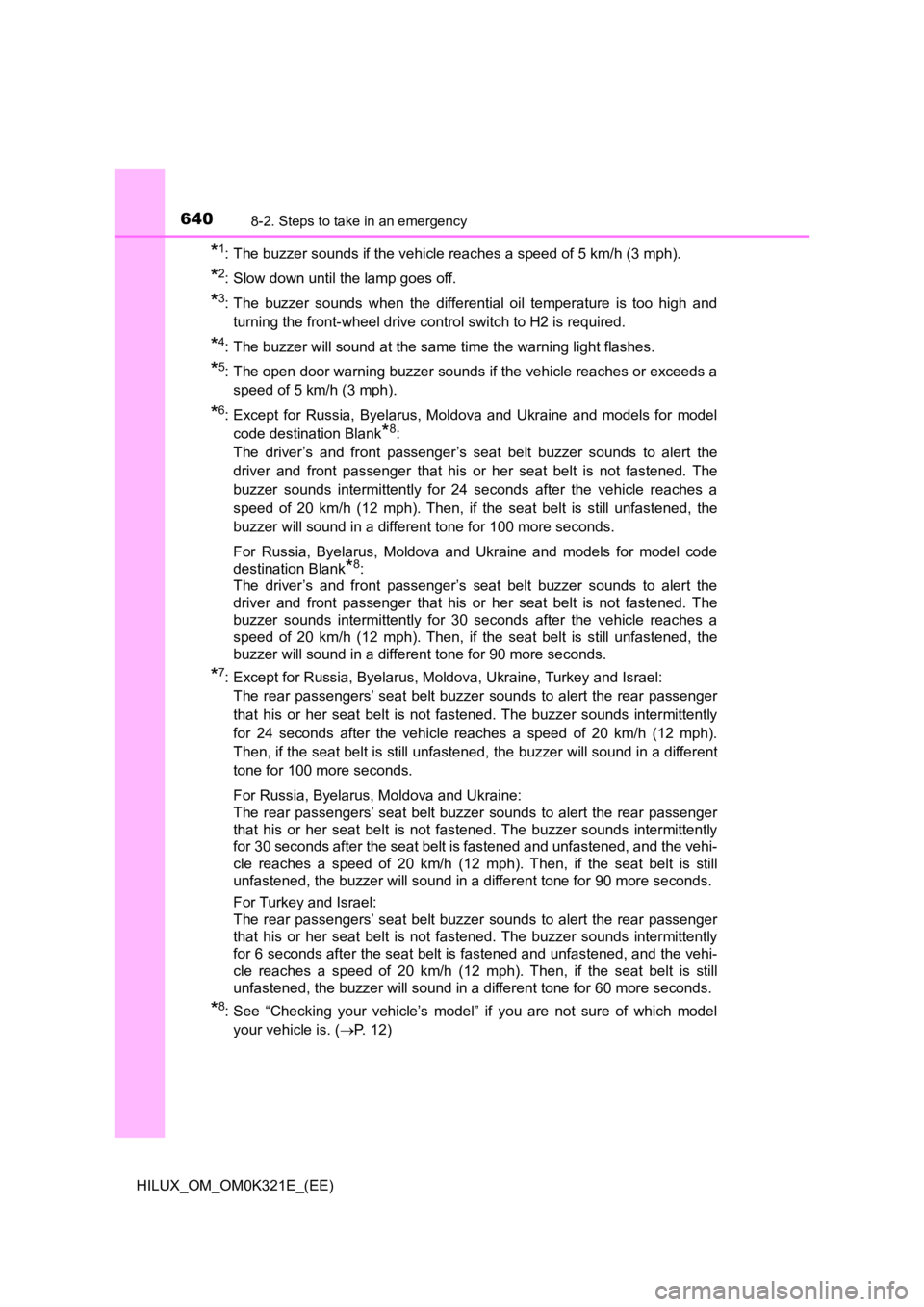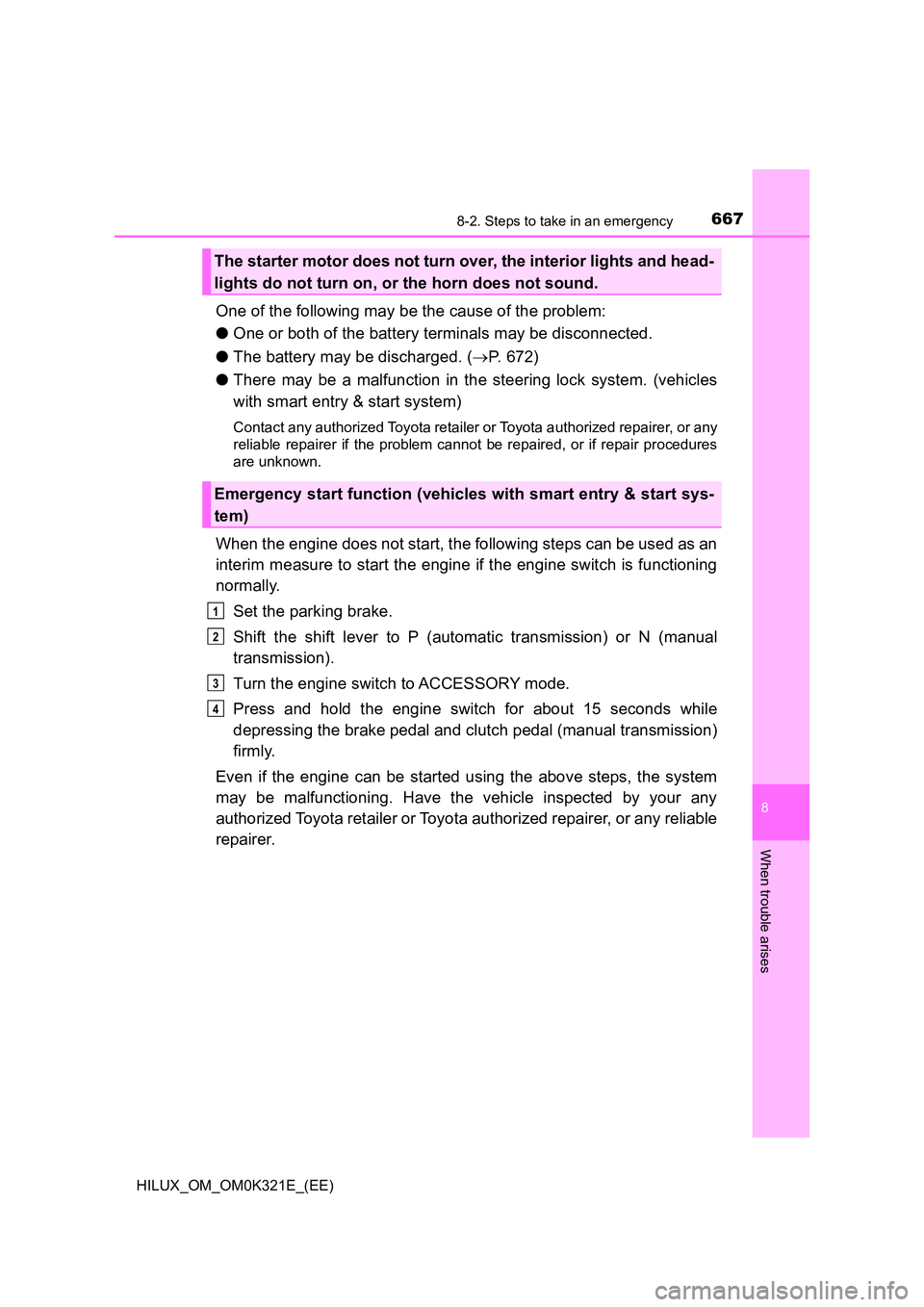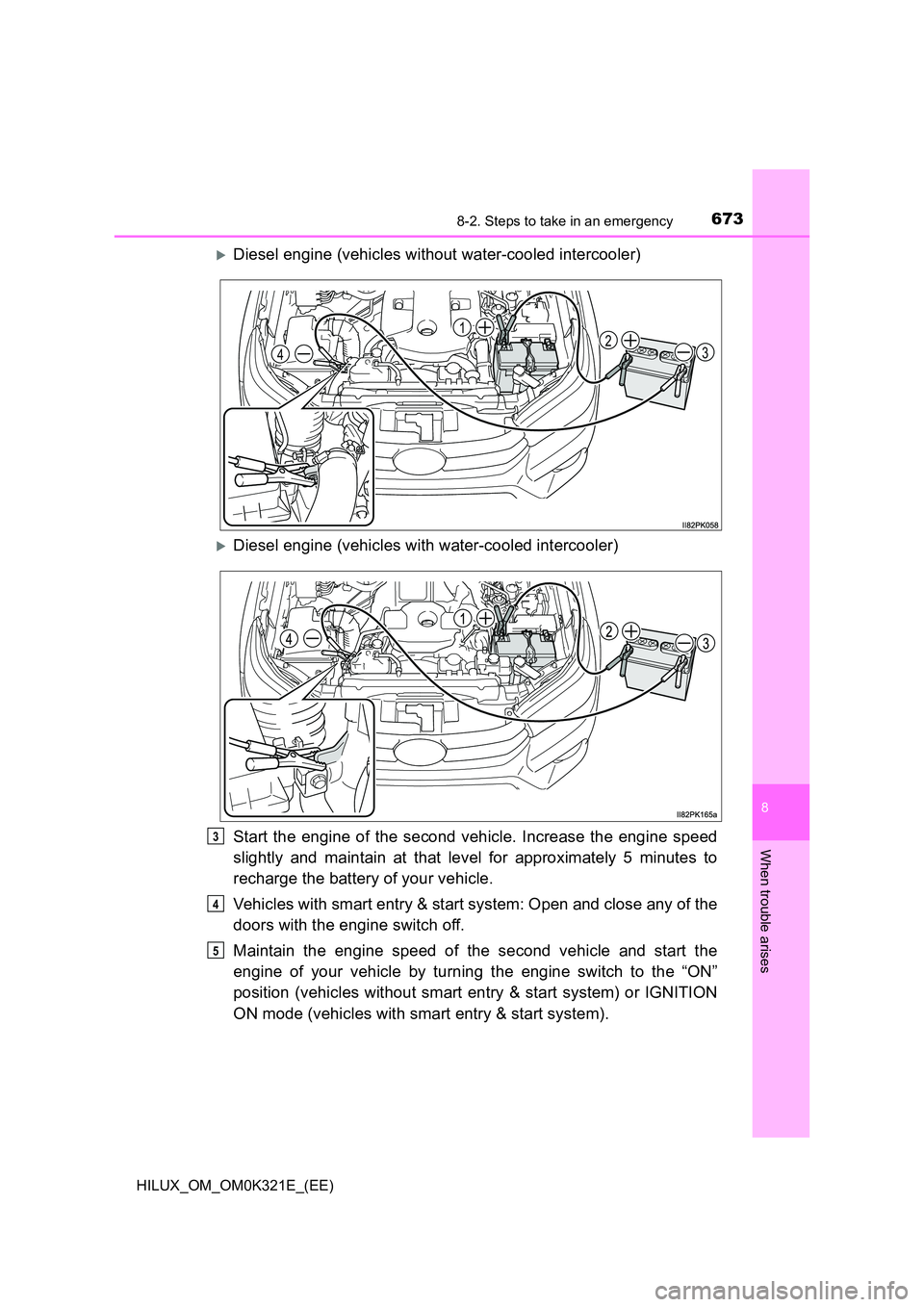2020 TOYOTA HILUX ECO mode
[x] Cancel search: ECO modePage 630 of 744

6308-2. Steps to take in an emergency
HILUX_OM_OM0K321E_(EE)
■While towing
If the engine is not running, the power assist for the brakes and steering will
not function, making steering and braking more difficult.
WARNING
Observe the following precautions.
Failure to do so may result in death or serious injury.
■ When towing the vehicle
■ While towing
● When towing using cables or chains, avoid sudden starts, etc. which place
excessive stress on the towing hooks, cables or chains. The towing hooks,
cables or chains may become damaged, broken debris may hit people,
and cause serious damage.
● Do not turn the engine switch to the “LOCK” position (vehicles without
smart entry & start system) or off (vehicles with smart entry & start sys-
tem).
There is a possibility that the steering wheel is locked and cannot be oper-
ated.
Pre Runner (2WD models): Be sure to
transport the vehicle with all four wheels
raised off the ground. If the vehicle is
towed with the tires contacting the
ground, the drivetrain and related parts
may be damaged or an accident may
occur due to a change in direction of the
vehicle.
4WD models: Be sure to transport the
vehicle with all four wheels raised off the
ground. If the vehicle is towed with the
tires contacting the ground, the drivetrain
and related parts may be damaged, and
the vehicle may fly off the truck.
Page 640 of 744

6408-2. Steps to take in an emergency
HILUX_OM_OM0K321E_(EE)
*1: The buzzer sounds if the vehicle reaches a speed of 5 km/h (3 mph).
*2: Slow down until the lamp goes off.
*3: The buzzer sounds when the differential oil temperature is too high and
turning the front-wheel drive control switch to H2 is required.
*4: The buzzer will sound at the same time the warning light flashes.
*5: The open door warning buzzer sounds if the vehicle reaches or exceeds a
speed of 5 km/h (3 mph).
*6: Except for Russia, Byelarus, Moldova and Ukraine and models for model
code destination Blank*8:
The driver’s and front passenger’s seat belt buzzer sounds to alert the
driver and front passenger that his or her seat belt is not fastened. The
buzzer sounds intermittently for 24 seconds after the vehicle reaches a
speed of 20 km/h (12 mph). Then, if the seat belt is still unfastened, the
buzzer will sound in a different tone for 100 more seconds.
For Russia, Byelarus, Moldova and Ukraine and models for model code
destination Blank*8:
The driver’s and front passenger’s seat belt buzzer sounds to alert the
driver and front passenger that his or her seat belt is not fastened. The
buzzer sounds intermittently for 30 seconds after the vehicle reaches a
speed of 20 km/h (12 mph). Then, if the seat belt is still unfastened, the
buzzer will sound in a different tone for 90 more seconds.
*7: Except for Russia, Byelarus, Moldova, Ukraine, Turkey and Israel:
The rear passengers’ seat belt buzze r sounds to alert the rear passenger
that his or her seat belt is not fastened. The buzzer sounds intermittently
for 24 seconds after the vehicle reaches a speed of 20 km/h (12 mph).
Then, if the seat belt is still unfastened, the buzzer will sound in a different
tone for 100 more seconds.
For Russia, Byelarus, Moldova and Ukraine:
The rear passengers’ seat belt buzze r sounds to alert the rear passenger
that his or her seat belt is not fastened. The buzzer sounds intermittently
for 30 seconds after the seat belt is fastened and unfastened, and the vehi-
cle reaches a speed of 20 km/h (12 mph). Then, if the seat belt is still
unfastened, the buzzer will sound in a different tone for 90 more seconds.
For Turkey and Israel:
The rear passengers’ seat belt buzze r sounds to alert the rear passenger
that his or her seat belt is not fastened. The buzzer sounds intermittently
for 6 seconds after the seat belt is fastened and unfastened, and the vehi-
cle reaches a speed of 20 km/h (12 mph). Then, if the seat belt is still
unfastened, the buzzer will sound in a different tone for 60 more seconds.
*8: See “Checking your vehicle’s model” if you are not sure of which model
your vehicle is. ( P. 1 2 )
Page 641 of 744

6418-2. Steps to take in an emergency
HILUX_OM_OM0K321E_(EE)
8
When trouble arises
*9: The parking brake engaged warning buzzer sounds if the vehicle reaches a
speed of approximately 5 km/h (3 mph) or more.
■ Passenger detection sensor, seat belt reminder and warning buzzer
● If luggage is placed on the passenger seat, the front passenger detection
sensor or the rear passenger detecti on sensor (if equipped) may cause the
warning light to flash and the warning buzzer to sound even if a passenger
is not sitting in the seat.
● If a cushion is placed on the seat, the sensor may not detect a passenger,
and the warning light may not operate properly.
■ If the malfunction indicator lamp comes on while driving
For some models, malfunction indicator lamp will come on if the fuel tank
becomes completely empty. If the fuel tank is empty, refuel the vehicle imme-
diately. The malfunction indicator lamp will go off after several trips.
If the malfunction indicator lamp does not go off, contact any authorized
Toyota retailer or Toyota authorized repai rer, or any reliable repairer as soon
as possible.
■ If the DPF system warning light comes on (if equipped)
The deposit collected in the filter needs to be regenerated.
P. 433
■ Warning buzzer
In some cases, the buzzer may not be heard due to being in a noisy location
or audio sound.
Page 667 of 744

6678-2. Steps to take in an emergency
HILUX_OM_OM0K321E_(EE)
8
When trouble arises
One of the following may be the cause of the problem:
● One or both of the battery terminals may be disconnected.
● The battery may be discharged. (P. 672)
● There may be a malfunction in the steering lock system. (vehicles
with smart entry & start system)
Contact any authorized Toyota retailer or Toyota authorized repairer, or any
reliable repairer if the problem cannot be repaired, or if repair procedures
are unknown.
When the engine does not start, the following steps can be used as an
interim measure to start the engine if the engine switch is functioning
normally.
Set the parking brake.
Shift the shift lever to P (automatic transmission) or N (manual
transmission).
Turn the engine switch to ACCESSORY mode.
Press and hold the engine switch for about 15 seconds while
depressing the brake pedal and clutch pedal (manual transmission)
firmly.
Even if the engine can be started using the above steps, the system
may be malfunctioning. Have the vehicle inspected by your any
authorized Toyota retailer or Toyota authorized repairer, or any reliable
repairer.
The starter motor does not turn over, the interior lights and head-
lights do not turn on, or the horn does not sound.
Emergency start function (vehicles with smart entry & start sys-
tem)
1
2
3
4
Page 671 of 744

6718-2. Steps to take in an emergency
HILUX_OM_OM0K321E_(EE)
8
When trouble arises
■Stopping the engine
Shift the shift lever to P (automatic transmission) or N (manual transmission)
and press the engine switch as you normally do when stopping the engine.
■ Replacing the key battery
As the above procedure is a temporary measure, it is recommended that the
electronic key battery be replaced immediately when the battery is depleted.
( P. 599)
■ Alarm (vehicles with alarm for Kazakhstan, Armenia and Morocco)
Using the mechanical key to lock the doors will not set the alarm system.
If a door is unlocked using the mechanical key when the alarm system is set,
the alarm may be triggered.
■ Changing engine switch modes
Release the brake pedal (automatic transmission) or clutch pedal (manual
transmission) and press the engine switch in step above.
The engine does not start and modes will be changed each time the switch is
pressed. ( P. 288)
■ When the electronic key does not work properly
● Make sure that the smart entry & start system has not been deactivated in
the customization setting. If it is off, turn the function on.
(Customizable features: P. 718)
● Check if battery-saving mode is set. If it is set, cancel the function.
( P. 199)
3
Page 673 of 744

6738-2. Steps to take in an emergency
HILUX_OM_OM0K321E_(EE)
8
When trouble arises
Diesel engine (vehicles without water-cooled intercooler)
Diesel engine (vehicles with water-cooled intercooler)
Start the engine of the second vehicle. Increase the engine speed
slightly and maintain at that level for approximately 5 minutes to
recharge the battery of your vehicle.
Vehicles with smart entry & start system: Open and close any of the
doors with the engine switch off.
Maintain the engine speed of the second vehicle and start the
engine of your vehicle by turning the engine switch to the “ON”
position (vehicles without smart entry & start system) or IGNITION
ON mode (vehicles with smart entry & start system).
324
1
3
4
5
Page 674 of 744

6748-2. Steps to take in an emergency
HILUX_OM_OM0K321E_(EE)
Once the vehicle’s engine has started, remove the jumper cables in
the exact reverse order from which they were connected.
Once the engine starts, have the vehicle inspected at any authorized
Toyota retailer or Toyota authorized repairer, or any reliable repairer
as soon as possible.
■ Starting the engine when the battery is discharged (vehicles with auto-
matic transmission)
The engine cannot be started by push-starting.
■ To prevent battery discharge
● Turn off the headlights and the audio system while the engine is off.
(Vehicles with Stop & Start system: Except when the engine is stopped due
to the Stop & Start system)
● Turn off any unnecessary electrical components when the vehicle is running
at a low speed for an extended period, such as in heavy traffic.
■ When the battery is removed or discharged
● Information stored in the ECU is cleared. When the battery is depleted, have
the vehicle inspected at any authorized Toyota retailer or Toyota authorized
repairer, or any reliable repairer.
● The power windows may not close normally. In this case, initialize the power
windows. (if equipped) ( P. 250)
■ Charging the battery
The electricity stored in the battery will discharge gradually even when the
vehicle is not in use, due to natural discharge and the draining effects of cer-
tain electrical appliances. If the vehicle is left for a long time, the battery may
discharge, and the engine may be unable to start. (The battery recharges
automatically during driving.)
■ When recharging or replacing the battery (vehicles with smart entry &
start system)
● In some cases, it may not be possible to unlock the doors using the smart
entry & start system when the battery is discharged. Use the wireless
remote control or the mechanical key to lock or unlock the doors.
● The engine may not start on the first attempt after the battery has recharged
but will start normally after the second attempt. This is not a malfunction.
● The engine switch mode is memorized by the vehicle. When the battery is
reconnected, the system will return to the mode it was in before the battery
was discharged. Before disconnecting the battery, turn the engine switch off.
If you are unsure what mode the engine switch was in before the battery dis-
charged, be especially careful when reconnecting the battery.
● Vehicles with Stop & Start system: After the battery terminals have been dis-
connected and reconnected or, the battery has been replaced, the Stop &
Start system may not automatically stop the engine for approximately 5 to
60 minutes.
6
Page 696 of 744

6969-1. Specifications
HILUX_OM_OM0K321E_(EE)
Gasoline engine (except for EURO V models*1)
*1: EURO V is an emission standard. If it is not clear that your vehicle meets
relevant standards, contact any authorized Toyota retailer or Toyota autho-
rized repairer, or any reliable repairer.
*2: The engine oil capacity is a reference quantity to be used when changing
the engine oil. Warm up and turn off the engine, wait more than 5 minutes,
and check the oil level on the dipstick.
■Engine oil selection
“Toyota Genuine Motor Oil” is used in your Toyota vehicle. Use
Toyota approved “Toyota Genuine Motor Oil” or equivalent to satisfy
the following grade and viscosity.
Oil grade:
0W-20, 5W-20, 5W-30 and 10W-30:
API grade SL “Energy-Conserving”, SM “Energy-Conserving”, SN
“Resource-Conserving” or SN PLUS “Resource-Conserving”; or
ILSAC multigrade engine oil
15W-40 and 20W-50:
API grade SL, SM, SN or SN PLUS multigrade engine oil
Recommended viscosity (SAE):
If you use SAE 10W-30 or a
higher viscosity engine oil in
extremely low temperatures,
the engine may become difficult
to start, so SAE 0W-20, 5W-20
or 5W-30 engine oil is recom-
mended.
Lubrication system
Oil capacity
(Drain and refill reference*2)
With filter
Without filter
5.6 L (5.9 qt., 4.9 Imp.qt.)
5.3 L (5.6 qt., 4.7 Imp.qt.)
Temperature range anticipated
before next oil change